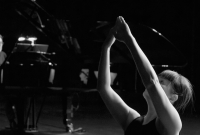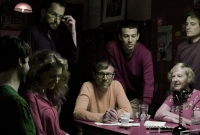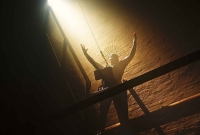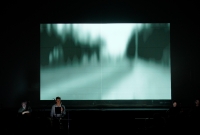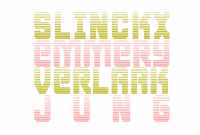ABOUT 'Piano and string quartet'
FUMIYO IKEDA: One day, quite out of the blue, a Canadian string quartet (the Bozzini Quartet) contacted me and suggested I would think about creating a choreography for Morton Feldman’s Piano and String Quartet. For me, this suggestion was something of a godsend and a mission at the same time. I promised them I’d take a listen.
Oddly enough, in the beginning I found it impossible to listen to this music, to concentrate on it for more than five minutes at a time. I had to keep on stopping the disc to go off and do something else! I was indeed coming out of a period in which I had been studying Bach’s music, in which everything was much clearer: A, B, C, repeat, A’, variation; a whole discipline and enjoyment of musical analysis, with the score to hand, that I had learnt at Rosas. With Morton Feldman’s music, I kept on feeling a sense of promise and expectation, the feeling that something was going to happen, and that that something wouldn’t come about in the end, or that things never work out how you expect, and it was making me terribly nervous — and then I would stop listening. But I didn’t change my mind, I had decided to keep on going until the end of the disc; I would go so far as to say that my anxiety made the work more and more interesting.
It was in this frame of mind that I went to see my musician friends at Ictus. I needed help with listening to it, even if deep down I knew that I had already said “yes” to the work.
Which dimension of the work did you say “yes” to?
F. I.: I have been working on memory for ten years - conscious and subconscious memory. That’s exactly what I could feel in the work of Morton Feldman: his music always makes you want to say: “Oh yes, I know that, I recognise this moment!” To the point that you think you can anticipate the music, guess what’s coming next. But no, in reality... at the precise moment when your memory thinks it has got a hold on things, everything has changed slightly. The aspect has been transformed. And you end up feeling...
... disorientated.
JEAN-LUC FAFCHAMPS: Disorientated, or perhaps: disarmed! I lecture in musical analysis and I am very well aware that that is a way of intellectually “arming” ourselves when studying music. But it doesn’t work like that with Morton Feldman.
Can you tell me about your own encounter with this music?
J-L F.: I graduated from the Conservatoire, at 23 years of age, after having studied a lot of pieces, and always pieces with lots of notes — amongst others I had developed quite a passion for Liszt! A concert producer gave me the opportunity to play Feldman, who I only knew by name at the time. It was supposed to take place two or three years before his death, we spoke of this composer as someone who prevented you from going round in circles, like a sort of antithesis of what was going on in Europe at the time. I went to a music shop to take a look at Feldman’s scores to try to get an idea of the length of the individual works, in quite a simplistic fashion I have to confess, according to the number of pages: I needed one that was 25 minutes long, and one of the scores seemed to correspond to this volume because it was the same thickness as Liszt’s Sonata. Only it turned out to be a one and a half hours long! I played it in concert and it was a revelation. I found out that it’s possible to play music without constantly having to wait and see what’s coming next...
Music that varies constantly is nothing new...
J-L F.: That’s true, but Feldman doesn’t compose “variations” which take you somewhere, all the while retaining a suggestion of their model. What he composes could be better described as “variants”. Mini-variant after mini-variant, small difference after small difference ... wandering around aimlessly, if I can put it like that.
And so, Fumiyo, you contacted Fafchamps in the hope of making yourself a choreographic aid from his musical analysis resources?
F. I: I basically contacted Fafchamps to be sure that I could stop using the analytical tool! While listening to Feldman’s music I feel like I’m looking out to sea, I get the same sensations: I’m sure that it’ll stay there, but that’s about all I can be sure of. I know that it’ll change, that there will be a high and a low tide, but I’ve no clue when they will occur. This is why I didn’t want to work measure by measure, motif by motif. I didn’t start out from a small unit. I looked into constructing a very long sentence, a fifteen-minute-long one. This sentence is made up of 135 words.
What is a choreographic “word”?
F. I.: It can come from a part of the body. I have a vocabulary of approximately 60 words which come from the body: an elbow, a finger, a lip, the act of breathing. And then a vocabulary of the same volume from animals: the crocodile, for example. By dancing my sentence five times I just about cover the duration of the music.
So you don’t worry about the music in detail? You’ve separated dance and music?
F. I.: No! I could say that this sentence has become the ear with which I am now, finally, listening to the music. When it comes down to it, I had to choreograph this music in order to really get it. Now I can hear all the differences. I can even hear words. And when, later on, you re-see the same gestures, they are no longer the same.
J-L F.: She couldn’t get the analytical tool to work, so she found her own one!
F. I.: I then divided the sentence up into 9 segments, so that I could vary the order in which it was played. This idea came naturally: you obviously had to recombine, apply an action to the structure. It was interesting, but I felt like I was having fun all on my own. All the more so seeing as I had used a random machine to combine my 135 words — because I believe that machines often get it right when you want to produce the most beautiful combinations — and I could have reproduced this randomness in real time during performances. But what would have been the point? What’s the point of adding iPads? The intensity of the sea changes, but waves are still waves. I gave up on that idea.
J-L F.: In this specific context the repetition creates more “difference” than variation. Feldman was a great collector of Persian carpets. You have to visualise the Iranian workers who make the carpets in their kitchens, identically reproducing their knots and patterns— but in reality, you’ll never find two the same. There is a very Proustian nostalgia which comes from all of that, the impression that every gesture is already a memory, even the first time around.
Feldman, a carpet collector, you said, but also a big fan of modern art...
J-L F.: Feldman would have undoubtedly become a painter if his eyes hadn’t been so bad. Imagine the scene, and him too, his eyes glued to the score, with his spidery scrawl. It’s an amazing paradox: this music conceived on such a large scale, which opens up such large spaces, was laboriously written by a man with his face glued to the page.
You mention the large scale... Is the duration of the music governed by a huge general curve?
F.I.: Yes, and that’s why I decided not to stay exactly in my place, as a sixth musician. There’s a change in place which, in spite of everything, takes a dramaturgy of the music into account. This music always evokes a sort of distance. And I too, might step away from the musicians. For a very long time the piano acts like a kind of release mechanism. The quartet takes second place. But things are inversed. There is a very moving point at which it starts again, when the quartet seems to have found a driving force, a dancing rhythm...
J-L F.: ... quite similar to a five-beat rhythm… The piano slows down a bit, the end seems to be indefinitely postponed and the string quartet takes centre stage. There is an interesting point that relates to the extent to which the pianist has to hold down the pedal from the very beginning till the very end of the work - he never lets you hear the silence. There is always some kind of resonance. The quartet can stop and give people the chance to listen to the silence. The quartet has this power to punctuate sound and silence, which the piano does not have access to.
Interview conducted by Jean-Luc Plouvier
>The page "Piano & String Quartet"
over 'piano and string quartet'
FUMIYO IKEDA: Dit werk, Piano and String Quartet van Morton Feldman, is me een beetje in de schoot geworpen op de dag dat een Canadees strijkkwartet (Quatuor Bozzini) me contacteerde om er een choreografie bij te bedenken. Ik beschouwde hun voorstel als een geschenk, en in zekere zin ook als een soort missie. Dus beloofde ik hen dat ik ernaar zou luisteren.
Vreemd genoeg kon ik in eerste instantie niet naar deze muziek luisteren. Ik kon me er niet langer dan vijf minuten op concentreren. Ik moest de plaat constant afzetten en iets anders doen! Ik had toen wel net een studieperiode achter de rug met muziek van Bach, waar alles mooi afgelijnd is: A, B, C, herhaling, A’, variatie; de gekende discipline maar ook natuurlijk het plezier van de muziekanalyse met de partituur in de hand – iets dat ik bij Rosas heb geleerd. In de muziek van Morton Feldman voelde ik voortdurend een belofte en een verwachting, ik had het gevoel dat er iets ging gebeuren, maar dat iets kwam er uiteindelijk nooit, of de dingen namen nooit de wending die je zou verwachten en dat verontrustte me — dus zette ik de muziek af. Dat betekent echter niet dat ik afzag van mijn besluit om de opname in zijn geheel te beluisteren, want hoewel ik er niet helemaal gerust in was, kan ik zelfs zeggen dat het stuk me steeds meer ging boeien.
Met die ingesteldheid ben ik naar Ictus gegaan, waarvan ik alle muzikanten al kende. Ik had hulp nodig om het stuk te beluisteren, hoewel ik diep vanbinnen wist dat ik al “ja” had gezegd op dit stuk.
Op welk specifiek aspect van het werk had je al “ja” gezegd?
F. I.: Ik werk nu al tien jaar rond het geheugen. Het bewuste en het onbewuste geheugen. En dat is precies wat ik bij Morton Feldman kon onderscheiden: zijn muziek geeft altijd zin om te zeggen: “O ja, dit ken ik, dit moment herken ik!”. Het gaat zelfs zo ver dat je kan anticiperen op de muziek, dat je bijna kan raden wat er zal volgen. Maar nee, eigenlijk … op het moment dat je denkt dat je geheugen het stuk kan vatten, verandert alles een beetje. De figuur is veranderd. En je voelt je …
... gedesoriënteerd.
JEAN-LUC FAFCHAMPS: Ja, gedesoriënteerd, of misschien zelfs weerloos en ontwapend! Ik ben zelf docent muziekanalyse, en ik weet heel goed dat het ons intellectueel “bewapent” om de muziek te vatten. Alleen, met Morton Feldman werkt dat niet zo.
Kan je beschrijven hoe je eerste ontmoeting met deze muziek voelde?
J-L F.: Ik was 23 jaar en kwam net uit het Conservatorium. Ik had veel stukken ingestudeerd, stukken met veel noten — ik had een passie voor Liszt ontwikkeld! En dan stelde een concertproducent me voor om stukken te spelen van Feldman, die ik toen enkel bij naam kende. Het was, geloof ik, twee of drie jaar voor hij stierf. Iedereen sprak over deze componist als iemand die er een broertje dood aan had in kringetjes rond te draaien, als een soort antithese voor wat er toen in Europa werd gedaan. Ik ben naar een muziekwinkel gegaan om de partituren van Feldman te bestuderen, en ik beoordeelde de lengte van de stukken – nogal stomweg moet ik zeggen – op het aantal pagina’s – ik leidde hieruit af dat de uitvoering me 25 minuten zou kosten. Een van de partituren kwam immers qua dikte overeen met de Sonate van Liszt dus ik dacht dat dit werk dus even lang zou duren. Niets was echter minder waar: uiteindelijk duurt het stuk maar liefst anderhalf uur! Ik heb het in concert gespeeld en het was een echte openbaring voor mij. Ik ontdekte dat je muziek kan maken zonder altijd te verwachten wat er gaat komen …
Muziek die altijd verandert, dat is nochtans niets nieuws …
J-L F.: Akkoord, maar Feldman componeert geen ‘variaties’ die je ergens heen leiden en de sporen van hun model met zich meedragen. Minivariatie na minivariatie, kleine verschillen hier en daar … die je op het verkeerde been zetten, als ik het zo mag zeggen.
En dus, Fumiyo, je hebt Fafchamps aangesproken in de hoop dat hij je van choreografisch nut kon zijn met behulp van zijn muziekanalysevaardigheden?
F. I.: Ik heb Fafchamps inderdaad aangesproken, maar dan om er zeker van te zijn dat ik de piste van de analyse achterwege kon laten! Als ik de muziek van Feldman beluister, heb ik altijd dezelfde indruk als wanneer ik de zee overschouw: ik ben er zeker van dat ze daar zal blijven, maar dat is ongeveer alles wat ik kan voorzien. Ik weet heel goed dat ze zal veranderen, dat het eerst eb zal worden en dan vloed, maar ik heb geen idee wanneer dat zal gebeuren. Daarom wilde ik niet maat per maat en motief per motief werken. Ik ben niet van een kleine eenheid vertrokken. Integendeel heb ik hier geprobeerd om een heel lange zin te vormen, een zin van wel vijftien minuten. En die zin bestaat uit 135 woorden.
Wat is een choreografisch “woord”?
F. I.: Dat kan vertrekken van een lichaamsdeel. Ik beschik over een woordenschat van ongeveer 60 woorden die iets met het lichaam te maken hebben: elleboog, vinger, lip, ademhaling. Zo heb ik ook een lijst met evenveel woorden uit het dierenrijk: krokodil, bijvoorbeeld. Als ik mijn zin vijf keer dans, dek ik ongeveer de duur van de muziek.
Maak je je dan geen zorgen over de details van de muziek? Je ziet de dans en de muziek los van elkaar?
F. I.: Nee, helemaal niet! Ik zou kunnen zeggen dat die zin het oor is geworden waarmee ik nu, eindelijk, de muziek hoor. Om ze te vatten, moest ik er een choreografie bij maken. Ik hoor nu alle verschillen. Ik hoor zelfs woorden. En als er later gebaren terugkomen die je al gezien hebt, zijn ze niet meer dezelfde.
J-L F.: Het ‘wapen’ van de analyse werkte niet, dus heeft ze haar eigen manier gevonden!
F. I .: Daarna heb ik de zin in negen segmenten ingedeeld, om te kunnen variëren met de volgorde ervan. Dat idee lijkt me natuurlijk: ik moest uiteraard wel nieuwe combinaties maken en een actie toepassen op de structuur. Het was interessant, maar ik had de indruk dat ik me op m’n eentje aan het bezighouden was. Ik heb trouwens ook een ‘random-machine’ gebruikt (een toevalsgenerator) om mijn 135 woorden te combineren — ik vind immers dat een machine vaak gelijk heeft als het erop aankomt de mooiste combinaties te maken — en ik zou dat toeval tijdens de voorstellingen in real time gereproduceerd kunnen hebben. Maar waar is dat goed voor? Waarom zouden we iPads toevoegen? De zee verandert van intensiteit, maar de golven blijven golven. Ik heb het dus gewoon zo gelaten.
J-L F.: In deze precieze context creëert herhaling meer ‘verschil’ dan variatie. Feldman was een fervent verzamelaar van Perzische tapijten. Beeld je die Iraanse werksters in die de tapijten in hun keuken maken, die altijd dezelfde knopen en motieven maken — maar in werkelijkheid zal je er nooit twee dezelfde vinden. Er gaat een zekere ‘Proustiaanse’ nostalgie uit van dit alles, de indruk dat elke beweging al een herinnering is, zelfs als je het voor de eerste keer ziet.
U zei dat Feldman tapijten verzamelde, maar hij was ook een groot liefhebber van moderne kunst …
J-L F.: Als hij niet zo’n slecht gezichtsvermogen had, zou Feldman zonder twijfel schilder geworden zijn. Je moet je inbeelden hoe hij, met de neus op de partituur gedrukt, zijn hanenpoten neerkrabbelde. Het is een schitterende paradox: muziek die bedacht werd voor uitvoeringen op grote schaal, voor enorme ruimtes, werd bijzonder moeizaam, met de neus op het blad, geschreven.
U vernoemt de grote schaal … Wordt de muziek in één grote boog van begin tot einde gespeeld?
F.I.: Ja, en dat is waarom ik niet exact op mijn plaats wilde blijven, als een zesde muzikant. Er is een verandering van plaats die – ondanks alles – blijk geeft van een dramaturgie in de muziek. Deze muziek creëert altijd een soort afstand. En ook ik neem uiteindelijk afstand van de muzikanten. De piano doet lange tijd dienst als een soort initiator. Het strijkkwartet komt er als tweede bij, maar dan worden de rollen omgekeerd. Op een bepaald moment is er een heel ontroerende ‘herstart’, wanneer het strijkkwartet een ‘drive’, een dansritme lijkt te vinden …
J-L F.: ... dat veel weg heeft van een maat van vijf… De piano vertraagt een beetje, het einde lijkt eeuwig uitgesteld te worden, en het strijkkwartet treedt op de voorgrond. Een interessant punt het vermelden waard: aangezien de pianist van begin tot einde de pedaal ingedrukt moet houden, creëert hij nooit een moment van stilte. Er is altijd een resonantie die blijft hangen. Het strijkkwartet kan dan wel weer stoppen en de stilte laten horen. Het strijkkwartet heeft de macht om geluid en stilte met elkaar af te wisselen, de piano niet.
Interview door Jean-Luc Plouvier
>The page "Piano & String Quartet"
à propos de 'piano and string quartet'
FUMIYO IKEDA : Cette oeuvre musicale, Piano and String Quartet de Morton Feldman, m’est un peu tombée du ciel, le jour où un quatuor à cordes canadien (le quatuor Bozzini) m’a contactée et m’a proposé d’y penser pour une chorégraphie. J’ai reçu cette proposition comme un cadeau et, d’une certaine manière, comme une sorte de mission. Je leur ai promis d’écouter cela.
Etrangement, il m’a d’abord été impossible d’écouter cette musique, de me concentrer dessus plus de cinq minutes d’affilée. Je devais sans cesse interrompre le disque pour passer à autre chose ! Il est vrai que je sortais d’une période d’étude de la musique de Bach, où tout était nettement plus clair : A, B , C, reprise, A’, variation ; tout une discipline et un plaisir de l’analyse musicale, partition en main, que j’avais appris chez Rosas. Avec la musique de Morton Feldman, je ressentais sans cesse une promesse et une attente, l’impression que quelque chose allait se passer, et que ce quelque chose n’advenait finalement jamais, ou que les choses ne tournaient jamais comme on pouvait s’y attendre et c’était terriblement angoissant — et je coupais. Mais je ne renonçais pas à ma décision, celle d’aller jusqu’au bout du disque ; je peux même dire que, à travers même mon inquiétude, la pièce m’intéressait de plus en plus.
C’est dans cet état d’esprit que je suis allé voir Ictus, dont je connaissais déjà tous les musiciens. J’avais besoin qu’on m’aide à l’écouter, même si au fond je savais qu’à cette oeuvre j’avais déjà dit « oui ».
A quelle dimension de l’oeuvre, au juste, avais-tu dit « oui » ?
F. I . : Je travaille depuis dix ans sur la mémoire. La mémoire consciente et la mémoire inconsciente. C’est exactement cela que je percevais chez Morton Feldman : sa musique donne toujours envie de dire : « Ah oui, ça je connais, ce moment je le reconnais ! » Au point que vous croyez pouvoir anticiper la musique, deviner la suite. Mais non, en fait... Au moment exact où la mémoire croit pouvoir saisir son objet, tout a légèrement changé. La figure s’est transformée. Et vous vous retrouvez ...
... désorienté.
JEAN-LUC FAFCHAMPS : Désorienté, ou peut-être : désarmé ! Je suis moi-même professeur d’analyse musicale, et je sais très bien que cela nous « arme » intellectuellement pour aborder la musique. Mais avec Morton Feldman, cela ne marche pas du tout comme cela.
Peux-tu évoquer ta propre rencontre avec cette musique ?
J-L F. : Je suis sorti du Conservatoire, à 23 ans, après avoir étudié beaucoup d’oeuvres, et toujours des œuvres avec beaucoup de notes — j’avais notamment développé une passion pour Liszt ! C’est alors qu’un producteur de concert m’a proposé de jouer du Feldman, dont je ne connaissais encore que le nom. Cela devait se passer deux ou trois années avant sa mort, on parlait de ce compositeur comme d’un empêcheur de tourner en rond, comme une sorte d’antithèse de ce qui se faisait alors en Europe. Je suis allé dans un magasin de musique examiner les partitions de ce Feldman, et j’ai jugé de la longueur des œuvres, assez bêtement je dois dire, en fonction de leur nombre de pages : il me fallait 25 minutes, et l’une des partitions me semblait correspondre à ce volume puisqu’elle avait l’épaisseur de la Sonate de Liszt. Oui mais voilà : il s’agissait finalement d’une pièce d’une heure et demie ! Je l’ai jouée en concert et ce fut pour moi une révélation. Je découvrais qu’on pouvait donc faire de la musique sans être toujours dans l’attente de ce qui allait venir...
Une musique qui varie sans cesse, ce n’était pourtant pas nouveau...
J-L F. : Oui, mais Feldman ne compose pas des « variations » qui te mèneraient quelque part, tout en gardant en elles la trace de leur modèle. Ce sont plutôt des « variantes ». Mini-variante après mini-variante, petite différence après petite différence ... qui errent, si je puis dire.
Et donc, Fumiyo, tu t’es adressée à Fafchamps en espérant te construire un outil chorégraphique à partir de ses ressources en analyse musicale ?
F. I : J’ai été vers Fafchamps, au fond, pour être bien certaine que je pouvais abandonner l’outil de l’analyse ! En écoutant la musique de Feldman, j’ai la même impression qu’en contemplant la mer : j’ai bien la certitude qu’elle restera là, mais c’est à peu près tout ce que je peux prévoir. Je sais bien que cela va changer, qu’il y aura marée haute et marée basse, mais je n’ai aucune idée du moment où cela surviendra. Du coup, je n’ai pas voulu travailler mesure par mesure, motif par motif. Je ne suis pas partie de la petite unité. J’ai cherché à construire une phrase très longue, au contraire, une phrase de quinze minutes. Cette phrase est composée de 135 mots.
Qu’est-ce qu’un « mot » chorégraphique ?
F. I. : Cela peut partir d’une partie du corps. J’ai un vocabulaire d’environ 60 mots qui partent du corps : un coude, un doigt, une lèvre, l’action de respirer. Et ensuite un vocabulaire de même volume à partir des animaux : le crocodile, par exemple. En dansant cinq fois ma phrase, je couvre à peu près la durée de la musique.
Tu ne te soucies pas de la musique dans son détail, alors ? Tu as disjoint danse et musique ?
F. I. : Non ! Je pourrais dire que cette phrase est devenue l’oreille à partir de laquelle j’entends maintenant, enfin, la musique. Au fond, j’ai dû chorégraphier cette musique pour pouvoir l’attraper. J’entends à présent toutes les différences. J’entends même des mots. Et quand des gestes que vous avez déjà vu reviennent plus tard, ils ne sont plus les mêmes.
J-L F. : L’arme de l’analyse ne pouvait pas marcher, elle a trouvé la sienne !
F. I . : J’ai ensuite découpé la phrase en 9 segments, pour pouvoir en varier l’ordre. Cette idée me semblait naturelle : il fallait évidemment re-combiner, appliquer une action sur la structure. C’était intéressant, mais j’avais l’impression de m’amuser seule. De même, j’avais utilisé une random-machine (un générateur de hasard) pour combiner mes 135 mots — car je trouve que la machine a souvent raison, en fait, lorsqu’il s’agit de produire les plus belles combinaisons — et j’aurais pu reproduire ce hasard en temps réel lors des performances. Mais à quoi bon ? A quoi bon ajouter des iPads ? La mer change d’intensité, mais les vagues restent les vagues. J’ai laissé tomber.
J-L F. : La répétition, dans ce contexte précis, crée plus de « différence » que la variation. Feldman était un grand collectionneur de tapis persans. Il faut visualiser ces travailleuses iraniennes qui confectionnent les tapis dans leurs cuisines, reproduisant leurs noeuds et leurs motifs à l’identique — mais en réalité, vous n’en trouverez jamais deux pareils. Il y a une nostalgie très proustienne qui se dégage de tout cela, l’impression que chaque geste est déjà un souvenir, même la première fois.
Feldman, collectionneur de tapis, disais-tu, mais aussi grand amateur d’art moderne...
J-L F. : Feldman serait sans doute devenu peintre s’il n’avait eu de si mauvais yeux. Il faut l’imaginer, lui aussi, les yeux collés à la partition, graphiant ses pattes de mouche. C’est un merveilleux paradoxe : cette musique pensée à une si grande échelle, qui ouvre des espaces si vastes, a été écrite laborieusement, le visage collé à la feuille.
Vous évoquez la grande échelle... La musique est-elle animée d’une grande courbe générale sur sa durée?
F.I. : Oui, et c’est pourquoi j’ai renoncé à rester exactement sur ma place, comme un sixième musicien. Il y a un changement de place qui rend compte d’une dramaturgie de la musique, malgré tout. Cette musique évoque toujours une sorte de distance. Et moi aussi, éventuellement, je prends mes distances d’avec les musiciens. Le piano, durant un très long moment, agit comme une sorte de déclencheur. Le quatuor vient en second. Mais les choses se renversent. Il y a un re-démarrage très émouvant, à un certain moment, où le quatuor semble trouver un « drive », un rythme de danse, ...
J-L F. : ... assez proche d’un rythme à cinq temps... Le piano ralentit un peu, la fin semble indéfiniment reportée, et le quatuor à cordes prend le premier plan. Il y a un point intéressant à noter : dans la mesure où le pianiste doit tenir la pédale du début à la fin de l’œuvre, il ne fait jamais entendre le silence. Il y a toujours une résonance qui traîne. Le quatuor, lui, peut s’arrêter et faire entendre le silence. Le quatuor a cette puissance de rythmer son et silence, à laquelle le piano n’a pas accès.
Propos recueillis par JL Plouvier
>The page "Piano & String Quartet"
